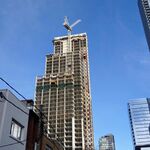W
wyliepoon
Guest
Link to article
The inferiority complex of 647
New area code lacks the cachet of 416, in fact, it's not even 905
Kelly Patrick
National Post
Saturday, November 18, 2006
When Derritt Mason moved to Little Italy in September, he was twice saddled with three little digits that made him feel like he was not a "real" Torontonian.
The 25-year-old educator with the National Film Board of Canada got stuck with a landline and a cellphone number with the city's 647 area code, the lesser-known companion to Toronto's iconic 416 code.
"I just feel like whoever is giving out cellphones is trying to prevent me from ever feeling like I really belong in Toronto," Mr. Mason says with a laugh.
"The 647 in some strange way is kind of similar to the 905 in that it's somehow not as authentic as a 416 area code."
Area codes might not mean much in another slice of the country, but in the Greater Toronto Area -- a place where area codes serve as a convenient shorthand for the urban/suburban divide and where backroom boys craft election strategies to win over "the 905" or "the 416" -- the three-digit sequence at the start of a phone number carries heavy symbolic weight.
The numbers 905 conjure up images of minivans, soccer fields and sprawl in the towns and cities that encircle the Big Smoke, while the digits 416 invite visions of smug, established urbanites living in the heart of Canada's biggest city.
So what does the relatively new 647 area code symbolize?
Glenn Pilley, the director of the Canadian Numbering Administrator, says the 647 code is only assigned to people who need new telephone numbers.
It is almost always assigned to new cellphones and BlackBerrys, because wireless carries have snapped up most of the exchange codes in 647, he added.
As a result the symbolism of 647 cuts two ways -- its either a badge of cool brandished by people too busy to be tied down to a landline or a three-digit reminder that the user is new to town and thus not a "real" Torontonian.
"I think 647 [signifies] the more mobile, flexible generation that just realizes you've got to have this phone on you," says Jared Gardner, a spokesman for Stephen LeDrew, the mayoral candidate who plunged into the race just before the nomination deadline and placed a distant third on Monday night.
Mr. LeDrew's campaign staff carried cellphones and BlackBerrys with the 647 area code. His more established rivals, David Miller and Jane Pitfield, had office landlines with a 416 area code.
"For our campaign, [647] kind of symbolized the fact that we came into this a little bit late so we needed to be as accessible as possible all the time," Mr. Gardner says. "We needed to have our campaign phone not necessarily based in an office, but on somebody's hip."
For others, the new area code is simply a hassle.
"I honestly couldn't get my head around the number," says Jennifer Atkinson, a 31-year-old account supervisor at Ketchum Public Relations Canada who received a 647 landline two years ago at her home in The Beach.
"A lot of people I spoke to, none of them could remember the 647 number. I felt cheated out of a 416 number."
Michelle Wasylyshen, 31, received a 647 landline two months ago when she moved from eastern Toronto to the city's central-west side.
Her cell phone has a 416 code.
"It's very backwards," she says. "You think of 647 as a mobile phone number."
The 647 area code was put in place in early 2001, after an explosion of new fax lines, Internet modems, pagers, cell phones and BlackBerrys in the Toronto area sent the people in charge of allocating Canadian phone numbers scrambling to overhaul the system before the supply of available 10-digit combinations dried up.
"If we were behind another two or three months, we actually would have run out of line numbers," Mr. Pilley says. "It was that close."
To help ease the transition, numbering gurus in Canada and the United States have moved away from "splitting" areas on the verge of exhausting the number supply to "overlaying" new area codes on top of existing ones.
The result? Canada has a handful of second-class area codes -- like 647 -- most people have never heard of, let alone dialled.
In fact, the 905 area code has had a secondary code for as nearly as long as the 416.
The 289 code has been in place since mid-2001.
Expect the meaning of those three digits to be parsed as 289 numbers multiple.
The inferiority complex of 647
New area code lacks the cachet of 416, in fact, it's not even 905
Kelly Patrick
National Post
Saturday, November 18, 2006
When Derritt Mason moved to Little Italy in September, he was twice saddled with three little digits that made him feel like he was not a "real" Torontonian.
The 25-year-old educator with the National Film Board of Canada got stuck with a landline and a cellphone number with the city's 647 area code, the lesser-known companion to Toronto's iconic 416 code.
"I just feel like whoever is giving out cellphones is trying to prevent me from ever feeling like I really belong in Toronto," Mr. Mason says with a laugh.
"The 647 in some strange way is kind of similar to the 905 in that it's somehow not as authentic as a 416 area code."
Area codes might not mean much in another slice of the country, but in the Greater Toronto Area -- a place where area codes serve as a convenient shorthand for the urban/suburban divide and where backroom boys craft election strategies to win over "the 905" or "the 416" -- the three-digit sequence at the start of a phone number carries heavy symbolic weight.
The numbers 905 conjure up images of minivans, soccer fields and sprawl in the towns and cities that encircle the Big Smoke, while the digits 416 invite visions of smug, established urbanites living in the heart of Canada's biggest city.
So what does the relatively new 647 area code symbolize?
Glenn Pilley, the director of the Canadian Numbering Administrator, says the 647 code is only assigned to people who need new telephone numbers.
It is almost always assigned to new cellphones and BlackBerrys, because wireless carries have snapped up most of the exchange codes in 647, he added.
As a result the symbolism of 647 cuts two ways -- its either a badge of cool brandished by people too busy to be tied down to a landline or a three-digit reminder that the user is new to town and thus not a "real" Torontonian.
"I think 647 [signifies] the more mobile, flexible generation that just realizes you've got to have this phone on you," says Jared Gardner, a spokesman for Stephen LeDrew, the mayoral candidate who plunged into the race just before the nomination deadline and placed a distant third on Monday night.
Mr. LeDrew's campaign staff carried cellphones and BlackBerrys with the 647 area code. His more established rivals, David Miller and Jane Pitfield, had office landlines with a 416 area code.
"For our campaign, [647] kind of symbolized the fact that we came into this a little bit late so we needed to be as accessible as possible all the time," Mr. Gardner says. "We needed to have our campaign phone not necessarily based in an office, but on somebody's hip."
For others, the new area code is simply a hassle.
"I honestly couldn't get my head around the number," says Jennifer Atkinson, a 31-year-old account supervisor at Ketchum Public Relations Canada who received a 647 landline two years ago at her home in The Beach.
"A lot of people I spoke to, none of them could remember the 647 number. I felt cheated out of a 416 number."
Michelle Wasylyshen, 31, received a 647 landline two months ago when she moved from eastern Toronto to the city's central-west side.
Her cell phone has a 416 code.
"It's very backwards," she says. "You think of 647 as a mobile phone number."
The 647 area code was put in place in early 2001, after an explosion of new fax lines, Internet modems, pagers, cell phones and BlackBerrys in the Toronto area sent the people in charge of allocating Canadian phone numbers scrambling to overhaul the system before the supply of available 10-digit combinations dried up.
"If we were behind another two or three months, we actually would have run out of line numbers," Mr. Pilley says. "It was that close."
To help ease the transition, numbering gurus in Canada and the United States have moved away from "splitting" areas on the verge of exhausting the number supply to "overlaying" new area codes on top of existing ones.
The result? Canada has a handful of second-class area codes -- like 647 -- most people have never heard of, let alone dialled.
In fact, the 905 area code has had a secondary code for as nearly as long as the 416.
The 289 code has been in place since mid-2001.
Expect the meaning of those three digits to be parsed as 289 numbers multiple.






